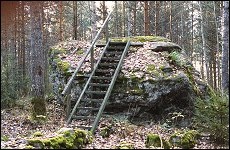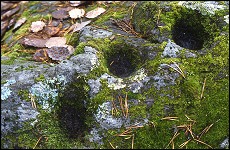
|
Iron-Age dwelling sites are often difficult to find. The Annikkala dwelling site in Lappeenranta, from the time of the Crusades and recorded history. The dwelling site stands out as a darker spot against the field in back. Picture, South Karelian Museum / Ville Laakso.
|


| |
Cup stones have been linked to fertility rites and worship of the dead. Ten cup stones or rocks are known in South Karelia. They were probably first used in the Iron Age, and their use continued long into the time of recorded history. The picture shows a cup stone from Silvu in Parikkala, with 8 cups ground out of its surface. The stone's cups are deeper than usual. Pictures, South Karelian Museum / Minna Kähtävä-Marttinen.
|
The Iron Age
The spread of the population in the Iron Age can be followed by observing the burial grounds, for they are often easier to notice than the dwelling sites, which in many places lie beneath current housing. A cup stone, that is, a stone or rock with cup-like indentations ground into it, may also signal a burial ground or dwelling site nearby. Sacrificial offerings such as grain and milk were brought to these cup stones, according to historical data.
|
